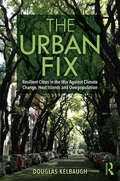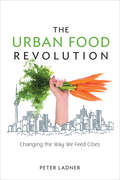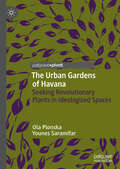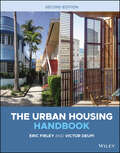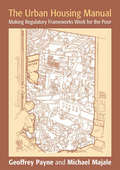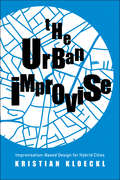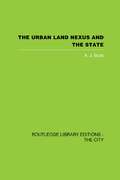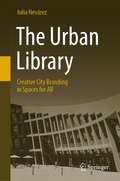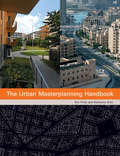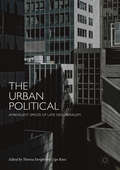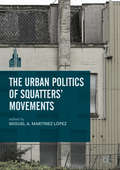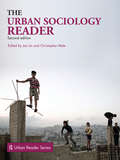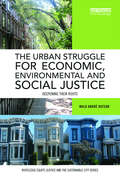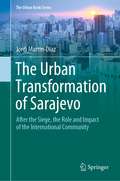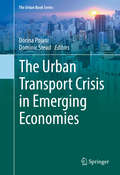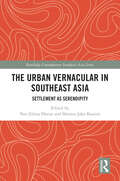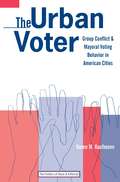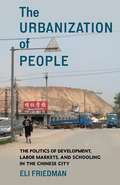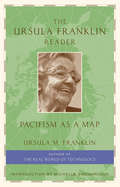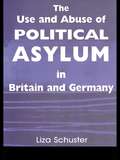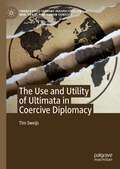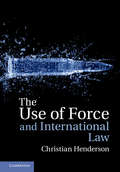- Table View
- List View
The Urban Fix: Resilient Cities in the War Against Climate Change, Heat Islands and Overpopulation
by Douglas KelbaughCities are one of the most significant contributors to global climate change. The rapid speed at which urban centers use large amounts of resources adds to the global crisis and can lead to extreme local heat. The Urban Fix addresses how urban design, planning and policies can counter the threats of climate change, urban heat islands and overpopulation, helping cities take full advantage of their inherent advantages and new technologies to catalyze social, cultural and physical solutions to combat the epic, unprecedented challenges humanity faces. The book fills a conspicuous void in the international dialogue on climate change and heat islands by examining both the environmental benefits in developed countries and the population benefit in developing countries. Urban heat islands can be addressed in incremental, manageable steps, such as planting trees and painting roofs white, which provide a more concrete and proactive sense of progress for policymakers and practitioners. This book is invaluable to anyone searching for a better understanding of the impact of resilient cities in the monumental and urgent fight against climate change, and provides the tools to do so.
The Urban Food Revolution: Changing the Way We Feed Cities
by Peter LadnerOur reliance on industrial agriculture has resulted in a food supply riddled with hidden environmental, economic and health care costs and beset by rising food prices. With only a handful of corporations responsible for the lion's share of the food on our supermarket shelves, we are incredibly vulnerable to supply chain disruption. The Urban Food Revolution provides a recipe for community food security based on leading innovations across North America. The author draws on his political and business experience to show that we have all the necessary ingredients to ensure that local, fresh sustainable food is affordable and widely available. He describes how cities are bringing food production home by:Growing community through neighborhood gardening, cooking and composting programsRebuilding local food processing, storage and distribution systemsInvesting in farmers markets and community supported agricultureReducing obesity through local fresh food initiatives in schools, colleges and universities.Ending inner-city food desertsProducing food locally makes people healthier, alleviates poverty, creates jobs, and makes cities safer and more beautiful. The Urban Food Revolution is an essential resource for anyone who has lost confidence in the global industrial food system and wants practical advice on how to join the local food revolution.
The Urban Gardens of Havana: Seeking Revolutionary Plants in Ideologized Spaces
by Ola Plonska Younes SaramifarThis book relates stories of everyday life revolving around small-scale urban gardens in Central Havana and focusing particularly on that of Marcelo, a seventy-four-year-old revolutionary and gardener. The urban gardens are contested spaces: though monitored and controlled by Cuban state institutions, they also offer possibilities of crafting life in resistance. The experiences the authors narrate are not ‘thick descriptions,’ linked to larger political issues, but rather rhizomatic observations that highlight the relationships between humans and non-humans within the nature-culture debate. Using these experiences, the authors argue that ‘the political’ reaches beyond the affairs of state and governance and should be seen as an all-encompassing part of life. The authors thereby invite the social sciences to focus on the microscopic and the day-to-day to illuminate how the political affairs of lives can be imagined differently.
The Urban Housing Handbook
by Eric Firley Victor DeupiTHE URBAN HOUSING HANDBOOK An insightful and revealing look at the intersection of housing and urban design In the newly revised Second Edition of The Urban Housing Handbook, Eric Firley and Victor Deupi deliver a vital design and analysis tool for housing practitioners, students, and researchers. The book outlines the characteristics of 30 of the most notable housing types from around the world, studied against a background of increasing densification. Each of the 30 chapters includes a fully-explored tradi tional example followed by one or two contemporary projects of similar spatial configuration that address changing trends in architecture and urban design. For this latest edition all contemporary examples have been updated and are now presented on two full spreads per chapter. Other features include: A rigorous analytical method that classifies the types according to four main categories (courtyard houses, row houses, compounds and apartment buildings) A thorough introduction to the relationship between an individual housing unit and the urban fabric that it creates through repetition A strong focus on dense metropolitan projects from around the world A set of key figures that translate visual information into metrics Unique, original drawings of illustrated housing accompanied by aerial and street-level context photos Conceived for architects and urban designers, The Urban Housing Handbook is also an ideal resource for urban planners, housing developers, builders, and housing trust professionals.
The Urban Housing Manual: Making Regulatory Frameworks Work for the Poor
by Geoffrey Payne Michael MajaleRed tape is a significant stumbling block to the provision of affordable shelter to the urban poor and, indeed, slums are largely the result of inappropriate regulatory frameworks. This practice-oriented manual tackles the issue of regulatory frameworks for urban upgrading and new housing development, and how they impact on access to adequate, affordable shelter and other key livelihood assets, in particular for the urban poor. It illustrates two methods for reviewing regulatory frameworks and expounds guiding principles for effecting change, informed by action research. The accompanying CD-Rom contains case studies, methods, exercises and tools, references and website links, and a video on reviewing regulatory frameworks.
The Urban Improvise: Improvisation-Based Design for Hybrid Cities
by Kristian KloecklA book for architects, designers, planners, and urbanites that explores how cities can embrace improvisation to improve urban life The built environment in today’s hybrid cities is changing radically. The pervasiveness of networked mobile and embedded devices has transformed a predominantly stable background for human activity into spaces that have a more fluid behavior. Based on their capability to sense, compute, and act in real time, urban spaces have the potential to go beyond planned behaviors and, instead, change and adapt dynamically. These interactions resemble improvisation in the performing arts, and this book offers a new improvisation-based framework for thinking about future cities. Kristian Kloeckl moves beyond the smart city concept by unlocking performativity, and specifically improvisation, as a new design approach and explores how city lights, buses, plazas, and other urban environments are capable of behavior beyond scripts. Drawing on research of digital cities and design theory, he makes improvisation useful and applicable to the condition of today’s technology-imbued cities and proposes a new future for responsive urban design.
The Urban Library: Creative City Branding in Spaces for All
by Julia NevárezThis book examines the role, history and function of public libraries in contemporary societies as motors that drive development. It analyses through case studies, how contemporary libraries have been redesigned to offer a new kind of public space while also reshaping neglected areas in cities. Broadly understood the book seeks to comprehend contemporary library design, urban development and the revitalization of specific urban areas.Important and world famous architects – star-architects – have designed signature architecture in the contemporary libraries selected for this volume. The examples to be showcased in the book include the main Seattle Public Library, Salt Lake City Public Library, New York Public Library, Spain Library Medellin, Colombia, Halifax Central Library Nova Scotia, Canada and Library of Alexandria in Egypt to offer examples of what constitute the approach to libraries and urban development in many cities around the world nowadays. Data in the form of interviews to library directors, librarians and users, tours of libraries, visual documentation and archival research have been collected for most public libraries included as case studies for the book.The impulse to archive has been framed and understood in the literature as a modern desire to control fleeting reality. Libraries as such respond to this desire by collecting, storing and circulating resources (books and other kinds of media). But more recently there has been an emphasis on the public character of library spaces in which people gather not only to obtain information and read by themselves but also to experience the very urban quality of proximity to others in more informal and less structured environments as public space. Community events characterize the programming of all the libraries included in the book. The design of these new libraries fit into urban development initiatives where libraries – like other iconic cultural spaces of cities – become central components to market cities for the consumption of culture. Libraries become sites to be visited and explored by tourists while providing services for residents. They are also machines to accelerate urban development especially in areas previously neglected by development.
The Urban Masterplanning Handbook
by Katharina Groen Eric FirleyA highly illustrated reference tool, this handbook provides comparative visual analysis of major urban extensions and masterplans around the world. It places an important new emphasis on the processes and structures that influence urban form, highlighting the significant impact that public or private landownership, management and funding might have on shaping a particular project. Each of the book's 20 subjects is rigorously analysed through original diagrams, scale drawings and descriptive texts, which are complemented by key statistics and colour photography. The case studies are presented in order of size rather than date or geographical location. This offers design professionals, developers and city planners, as well as students of architecture and urban design informed organisational and formal comparisons, leading to intriguing insights.A wide geographical range of contemporary and historic masterplans are featured. These encompass European projects from the 19th century to the present day: Belgravia in London, Sarphatipark in Amsterdam, Potsdamer Platz in Berlin, La Défense Seine Arche in Paris and Hammarby Sjöstad in Stockholm. In North America, the postwar development of Stuyvesant Town in Manhattan is also the subject of a case study. More recent and ongoing international urban schemes are included, such as Puerto Madero in Buenos Aires, Downtown Dubai and the New Central Business District in Beijing.
The Urban Political
by Ugo Rossi Theresa EnrightThis book examines the political and economic trajectories of cities following the 2008 financial crisis. The authors claim that in this era--which they dub "late neoliberalism"--urban spaces, institutions, subjectivities, and organizational forms are undergoing processes of radical transformation and recomposition. The volume deftly argues that the urban political horizon of late neoliberalism is ambivalent; marked by many progressive mobilizations for equality and justice, but also by regressive forces of austerity, exploitation, and domination.
The Urban Politics of Squatters' Movements
by Miguel A. Martínez LópezThis volume sheds light on the development of squatting practices and movements in nine European cities (Madrid, Barcelona, Seville, Rome, Paris, Berlin, Copenhagen, Rotterdam and Brighton) by examining the numbers, variations and significant contexts in their life course. It reveals how and why squatting practices have shifted and to what extent they engender urban movements. The book measures the volume and changes in squatting over various decades, mostly by focusing on Squatted Social Centres but also including squatted housing. In addition, it systematically compares the cycles, socio-spatial structures and the political implications of squatting in selected cities. This collection highlights how squatters’ movements have persisted over more than four decades through different trajectories and circumstances, especially in relation to broader protest cycles and reveals how political opportunities and constraints influence the conflicts around the legalisation of squats.p>
The Urban Sociology Reader (Routledge Urban Reader Series)
by Christopher Mele Jan LinThe urban world is an exciting terrain for investigating the central institutions, structures and problems of the social world and how they have transformed through the last 200 years. This Reader comprises sections on urban social theory, racial and social difference in the city, culture in everyday life, culture and the urban economy, globalization and transnational social relations and the regulation of urban space. Drawing together seminal selections covering the nineteenth to the twenty-first centuries, this Reader includes forty-three significant writings from eminent names such as Simmel, Wirth, Park, Burgess, DuBois, Zukin, Sassen, and Harvey. The 2nd edition illuminates more recent urban issues such as sprawl, sustainability, immigration and urban protest. Selections are predominantly sociological, but some readings cross disciplinary boundaries. Providing an essential resource for students of urban studies, this book brings together important but, till now, widely dispersed writings. Editorial commentaries precede each entry; introducing the text, demonstrating its significance, and outlining the issues surrounding its topic, whilst the associated bibliography enables deeper investigations.
The Urban Struggle for Economic, Environmental and Social Justice: Deepening their roots (Routledge Equity, Justice and the Sustainable City series)
by Malo André HutsonThis book discusses the current demographic shifts of blacks, Latinos, and other people of colour out of certain strong-market cities and the growing fear of displacement among low-income urban residents. It documents these populations' efforts to remain in their communities and highlights how this leads to community organizing around economic, environmental, and social justice. The book shows how residents of once-neglected urban communities are standing up to city economic development agencies, influential real estate developers, universities, and others to remain in their neighbourhoods, protect their interests, and transform their communities into sustainable, healthy communities. These communities are deploying new strategies that build off of past struggles over urban renewal. Based on seven years of research, this book draws on a wealth of material to conduct a case study analysis of eight low-income/mixed-income communities in Boston, New York, San Francisco, and Washington, DC. This timely book is aimed at researchers and postgraduate students interested in urban policy and politics, community development, urban studies, environmental justice, urban public health, sociology, community-based research methods, and urban planning theory and practice. It will also be of interest to policy makers, community activists, and the private sector.
The Urban Transformation of Sarajevo: After the Siege, the Role and Impact of the International Community (The Urban Book Series)
by Jordi Martín-DíazFollowing the signing of the peace agreement and the end of three-and-a-half years of siege, Sarajevo simultaneously experienced a double transition, from war to peace and from socialism to capitalism, that was marked by an increasing international intervention. This book presents a study of the urban transformation of Sarajevo during the post-war period and considers both the role and the impact of the international community in its spatial and ethnic configuration. Part I focuses on the period of maximum international involvement developed at local level, from December 1995 until 2003, and comprises chapters on the ethno-territorial division of the city, the reconstruction of its ethnic diversity and the liberal transition fostered and imposed internationally. Part II deals with the impact of these policies on the current spatial, functional and ethnic configuration in the area of Sarajevo.
The Urban Transport Crisis in Emerging Economies
by Dorina Pojani Dominic SteadThis edited volume discuses urban transport issues, policies, and initiatives in twelve of the world's major emerging economies - Brazil, China, Colombia, India, Indonesia, Iran, Mexico, Nigeria, Russia, South Africa, Turkey, and Vietnam - countries with large populations that have recently experienced large changes in urban structure, motorization and all the associated social, economic, and environmental impacts in positive and negative senses. Contributions on each of these twelve countries focus on one or more major cities per country. This book aims to fill a gap in the transport literature that is crucial to understanding the needs of a large portion of the world's urban population, especially in view of the southward shift in economic power. Readers will develop a better understanding of urban transport problems and policies in nations where development levels are below those of richer countries (mainly in the northern hemisphere) but where the rate of economic growth is often increasing at a faster rate than the wealthiest nations.
The Urban Vernacular in Southeast Asia: Settlement as Serendipity (Routledge Contemporary Southeast Asia Series)
by Nor Zalina Harun and Shireen Jahn KassimThis book constructs a number of discourses, dialectics and analyses across the disciplines of urban form, architecture and urban experience, thus incorporating both conservation and design issues.It bridges the gap between practice and theory by reconstructing the role of the “village” or “vernacular” in the discourses and trends of the twenty-first century post-Covid19 environment. Bringing together for the first time the confluences of theory and practice in the “urban vernacular” and the “urban village,” the contributors use vernacular concepts and settings as a common framework serving as cultural bridges, connecting traditional forms, ecologies and habitats to new global ideas, industrial economies and access to developing urban sustainability, design, planning and services in Asia's rising megacities. The book begins with concerns of urban layout and morphology, aiming to establish discourse, shared principles and terminology around conventional ideas of the “village” or traditional settlements' apparently organic and disordered nature. It then moves into architectural dimensions, capturing formal cases of how the “vernacular” or traditional “indigenous” local concepts have inspired new ideas in award-winning architecture and hence the importance of re-examining the vernacular in light of the ongoing need to produce a more sustainable and place-conscious fit in modern architecture and urban planning.The book will be of interest to researchers in the fields of architecture, urban planning and design, urban geography, design studies, landscape architecture, history of architecture/urbanism and Asian Studies, in particular those concerning Southeast Asia.
The Urban Voter
by Karen M. KaufmannKaren Kaufmann's groundbreaking study shows that perceptions of interracial conflict can cause voters in local elections to focus on race, rather than party attachments or political ideologies. Using public opinion data to examine mayoral elections in New York and Los Angeles over the past 35 years, Kaufmann develops a contextual theory of local voting behavior that accounts for the Republican victories of the 1990s in these overwhelmingly Democratic cities and the "liberal revivals" that followed. Her conclusions cast new light on the interactions between government institutions, local economies, and social diversity. The Urban Voter offers a critical analysis of urban America's changing demographics and the ramifications of these changes for the future of American politics. This book will interest scholars and students of urban politics, racial politics, and voting behavior; the author's interdisciplinary approach also incorporates theoretical insights from sociology and social psychology. The Urban Voter is appropriate for both undergraduate and graduate level courses.
The Urbanism of Exception
by Martin J. MurrayThis book challenges the conventional (modernist-inspired) understanding of urbanization as a universal process tied to the ideal-typical model of the modern metropolis with its origins in the grand Western experience of city-building. At the start of the twenty-first century, the familiar idea of the 'city' - or 'urbanism' as we know it - has experienced such profound mutations in both structure and form that the customary epistemological categories and prevailing conceptual frameworks that predominate in conventional urban theory are no longer capable of explaining the evolving patterns of city-making. Global urbanism has increasingly taken shape as vast, distended city-regions, where urbanizing landscapes are increasingly fragmented into discontinuous assemblages of enclosed enclaves characterized by global connectivity and concentrated wealth, on the one side, and distressed zones of neglect and impoverishment, on the other. These emergent patterns of what might be called enclave urbanism have gone hand-in-hand with the new modes of urban governance, where the crystallization of privatized regulatory regimes has effectively shielded wealthy enclaves from public oversight and interference.
The Urbanization of Forced Displacement: UNHCR, Urban Refugees, and the Dynamics of Policy Change (McGill-Queen's Refugee and Forced Migration Studies #6)
by Neil James CrawfordDisplacement in the twenty-first century is urbanized. The United Nations Refugee Agency (UNHCR), the world’s largest humanitarian organization and the main body charged with assisting displaced people globally, estimates that over 60 per cent of refugees now live in urban areas, a proportion that only increases in the case of internally displaced people and asylum seekers.Though cities and local authorities have become essential participants in the protection of refugees, only three decades ago they were considered to sit firmly beyond UNHCR’s remit, with urban refugees typically characterized as aberrations. In The Urbanization of Forced Displacement Neil James Wilson Crawford examines the organization’s response to the growing number of refugees migrating to urban areas. Introducing a broader study of policy-making in international organizations, Crawford addresses how and why UNHCR changed its policy and practice in response to shifting trends in displacement. Citing over 400 primary UN documents, Crawford provides an in-depth study of the internal and external pressures faced by UNHCR – pressures from above, below, and within – that explain why it has radically transformed its position from the 1990s onward.UNHCR and global refugee policies have come to play an increasingly important role in the governance of global displacement. The Urbanization of Forced Displacement sheds new light on how the organization works and how it conceives its role in global politics today.
The Urbanization of Green Internationalism (Cities and the Global Politics of the Environment)
by Yonn DierwechterThe recent rise of cities in global environmental politics has stimulated remarkable debates about sustainable urban development and the geopolitics of a changing world order no longer defined by tightly bordered national regimes. This book explores this major theme by drawing on approaches that document the diverse histories and emergent geographies of “internationalism.” It is no longer possible, the book argues, to analyze the global politics of the environment without considering its various urbanization(s), wherein multiple actors are reforming, reassembling and adapting to nascent threats posed by global ecological decay. The ongoing imposition and abrasion of different world orders—Westphalian and post-Westphalian—further suggests we need a wider frame to capture new kinds of urbanized spaces and global green politics. The book will appeal to students, scholars, and practitioners interested in global sustainability, urban development, planning, politics, and international affairs. Case studies and grounded examples of green internationalism in urban action ultimately explore how select city-regions like Cape Town, Los Angeles, and Melbourne are trying to negotiate and actually work through this postulated dilemma.
The Urbanization of People: The Politics of Development, Labor Markets, and Schooling in the Chinese City
by Eli FriedmanAmid a vast influx of rural migrants into urban areas, China has allowed cities wide latitude in providing education and other social services. While millions of people have been welcomed into the megacities as a source of cheap labor, local governments have used various tools to limit their access to full citizenship.The Urbanization of People reveals how cities in China have granted public goods to the privileged while condemning poor and working-class migrants to insecurity, constant mobility, and degraded educational opportunities. Using the school as a lens on urban life, Eli Friedman investigates how the state manages flows of people into the city. He demonstrates that urban governments are providing quality public education to those who need it least: school admissions for nonlocals heavily favor families with high levels of economic and cultural capital. Those deemed not useful are left to enroll their children in precarious resource-starved private schools that sometimes are subjected to forced demolition. Over time, these populations are shunted away to smaller locales with inferior public services.Based on extensive ethnographic research and hundreds of in-depth interviews, this interdisciplinary book details the policy framework that produces unequal outcomes as well as providing a fine-grained account of the life experiences of people drawn into the cities as workers but excluded as full citizens.
The Ursula Franklin Reader: Pacifism as a Map
by Ursula FranklinFeminist, educator, Quaker, and physicist, Ursula Franklin has long been considered one of Canada’s foremost advocates and practitioners of pacifism. The Ursula Franklin Reader: Pacifism as a Map is a comprehensive collection of her work, and demonstrates subtle, yet critical, linkages across a range of subjects: the pursuit of peace and social justice, theology, feminism, environmental protection, education, government, and citizen activism. This thoughtful collection, drawn from more than four decades of research and teaching, brings readers into an intimate discussion with Franklin, and makes a passionate case for how to build a society centered around peace.
The Use and Abuse of Political Asylum in Britain and Germany (British Politics and Society)
by Liza SchusterAll European states have the legal right to grant asylum but only Germany is obliged by law to do so. Liza Schuster contributes to the asylum debate primarily in the area of comparative politics in this study of British and German policies on asylum practice.
The Use and Utility of Ultimata in Coercive Diplomacy (Twenty-first Century Perspectives on War, Peace, and Human Conflict)
by Tim SweijsUniversity of Southern Denmark, Denmark Ultimata feature as a core concept in the coercive diplomacy scholarship. Conventional wisdom holds that pursuing an ultimatum strategy is risky. This book shows that the conventional wisdom is wrong on the basis of a new dataset of 87 ultimata issued from 1920–2020. It provides a historical examination of ultimata in Western strategic, political, and legal thought since antiquity until the present, and offers a four-pronged typology that explains their various purposes and effects: 1) the dictate, 2) the conditional war declaration, 3) the bluff, and 4) the brinkmanship ultimatum. The book yields a better understanding of interstate threat behaviour at a time of surging competition. Background materials can be consulted at www.coercivediplomacy.com.
The Use of Force and International Law: The Impact Of The United States Upon The Jus Ad Bellum In The Post-cold War Era (The\ashgate International Law Ser.)
by Christian HendersonThe Use of Force and International Law offers an authoritative overview of international law governing the resort to force. Looking through the prism of the contemporary challenges that this area of international law faces, including technology, sovereignty, actors, compliance and enforcement, this book addresses key aspects of international law in this area: the general breadth and scope of the prohibition of force, what is meant by 'force', the use of force through the UN and regional organisations, the use of force in peacekeeping operations, the right of self-defence and the customary limitations upon this right, forcible intervention in civil conflicts, the controversial doctrine of humanitarian intervention. <P><P>Suitable for advanced undergraduate and postgraduate students, academics and practitioners, The Use of Force and International Law offers a contemporary, comprehensive and accessible treatment of the subject. Follows a clear and accessible structure to better support lecturers teach their courses and aid student understanding.<P> Clearly lays out the distinction between concepts and terms to enable students to grasp the fundamental distinctions before delving deeper into the subject.<P> Comprehensive references to primary and secondary sources support student understanding of the breadth of legal resources in the field and aid further research.
